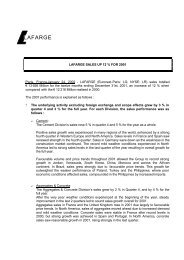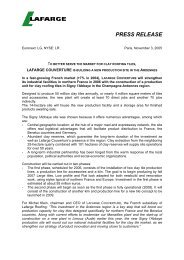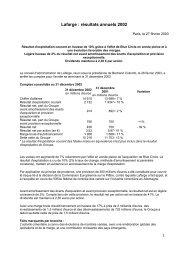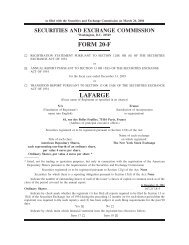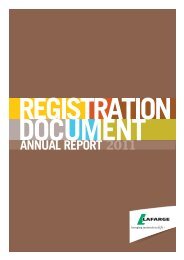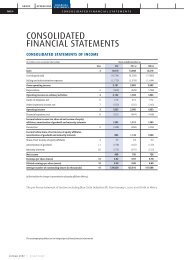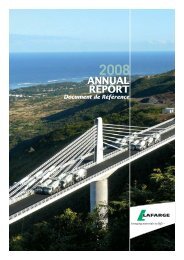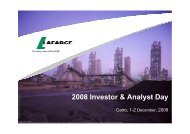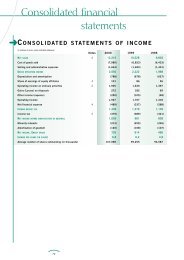2005 Sustainability Report - Lafarge
2005 Sustainability Report - Lafarge
2005 Sustainability Report - Lafarge
Create successful ePaper yourself
Turn your PDF publications into a flip-book with our unique Google optimized e-Paper software.
PANEL<br />
Supporting the development of our employees<br />
SAFETY MANAGEMENT<br />
AT LAFARGE<br />
Peter Hoddinott,<br />
Executive Vice President of the Latin America<br />
region, Cement<br />
Managers must not compromise on standards<br />
in three key areas: equipment,<br />
management tools and behavior. In Brazil, for<br />
instance, it is common practice to overload<br />
trucks. To bring our actions into line with our<br />
beliefs, we put an end to this practice in<br />
spite of the direct impact on our competitiveness.<br />
Good practices notably include the<br />
application of policies, protocols and implementation<br />
of management systems. In<br />
Mexico, for instance, we now have 22 agents<br />
responsible for coordinating safety initiatives<br />
by rallying over 800 people, in spite of the<br />
major difficulties we encountered with the<br />
construction of a new cement plant. Behavior<br />
is the final point on our list: securing the<br />
backing of individuals for safety initiatives<br />
and encouraging them to alter their behavior<br />
are the hardest, but also the most effective<br />
stages in the process. They are among the<br />
permanent challenges facing managers!<br />
PATRICE PONCEAU<br />
European Works Council<br />
PAGE 30 | <strong>2005</strong> SUSTAINABILITY REPORT | LAFARGE<br />
03 04 05<br />
OCCUPATIONAL FREQUENCY RATE<br />
Occupational frequency rate Group 6.56 4.70 3.87<br />
Occupational frequency rate Cement 3.32 2.61 2.48<br />
Occupational frequency rate Aggregates & Concrete 6.89 4.75 3.55<br />
Occupational frequency rate Gypsum 4.99 5.43 5.10<br />
Occupational frequency rate Roofing 17.96 10.89 7.88<br />
1<br />
OCCUPATIONAL SEVERITY RATE 2<br />
03 04 05<br />
Occupational severity rate Group 0.24 0.22 0.18<br />
Occupational severity rate Cement 0.16 0.14 0.14<br />
Occupational severity rate Aggregates & Concrete 0.28 0.25 0.20<br />
Occupational severity rate Gypsum 0.27 0.28 0.27<br />
Occupational severity rate Roofing 0.46 0.37 0.20<br />
Roofing was integrated into the Group in 1998 and the programs were therefore implemented later than<br />
in the other businesses and the health and safety performances began to be recorded in 2002. Since 2004,<br />
Roofing has accelerated its efforts to erase this delay. In Aggregates & Concrete, the progress is the result of the<br />
implementation of safety management systems and of fundamental actions carried out over the last few years.<br />
Gypsum and Cement face a plateau phenomenon through a slowdown of their progression. In 2006,<br />
we will renew the approach to make it more dynamic.<br />
Note: This data covers 100% of the workforce.<br />
Benchmark> <strong>Lafarge</strong>'s Cement business registered by far the lowest accident frequency rate of the 5 global<br />
competitors who disclose this indicator, its rate being 5 points lower than that of its next best competitor.<br />
Furthermore, <strong>Lafarge</strong> registered the second best fatality rate of the 3 cement companies who publish<br />
this indicator.<br />
1 | Number of accidents leading to loss of time by million of hours worked.<br />
2 | Number of calendar days lost as a result of accidents by thousand of hours worked.<br />
<strong>Lafarge</strong> continues to progress in making health and safety a reality within the Group. A series of action<br />
plans has been implemented and is beginning to produce tangible effects at operational level. Regarding<br />
health concerns, one-off initiatives have been carried out locally, against the avian flu and chikungunia<br />
outbreaks, and, in a more long-term perspective, against HIV/AIDS. Furthermore, studies are being<br />
conducted to assess the effects of production on employee health so as to prevent occupational<br />
illnesses. Bruno Lafont, <strong>Lafarge</strong>’s CEO even made an official announcement to shareholders on February<br />
23, 2006 to publicize the Group’s health and safety ambitions. The main challenge will be to<br />
involve sub-contractors and suppliers in this dynamic.




